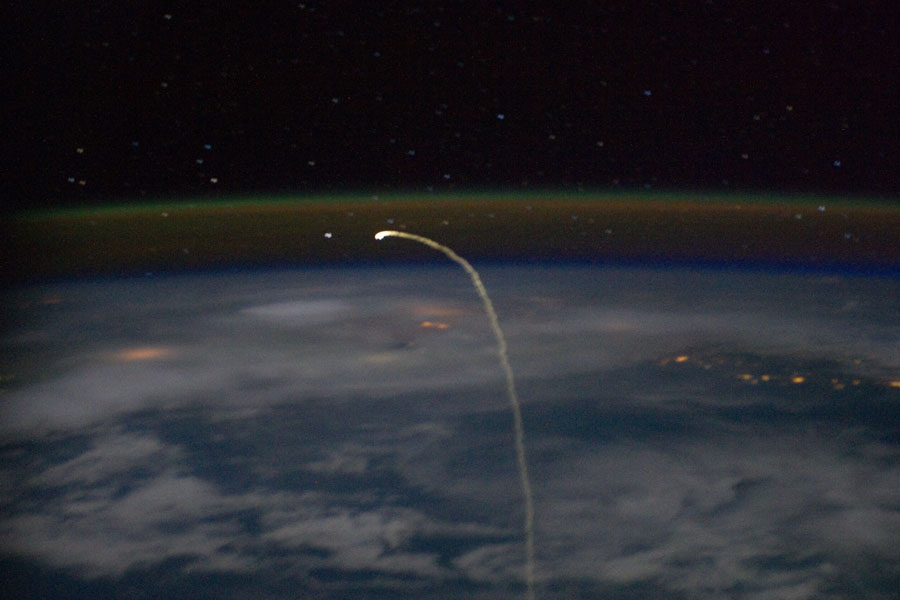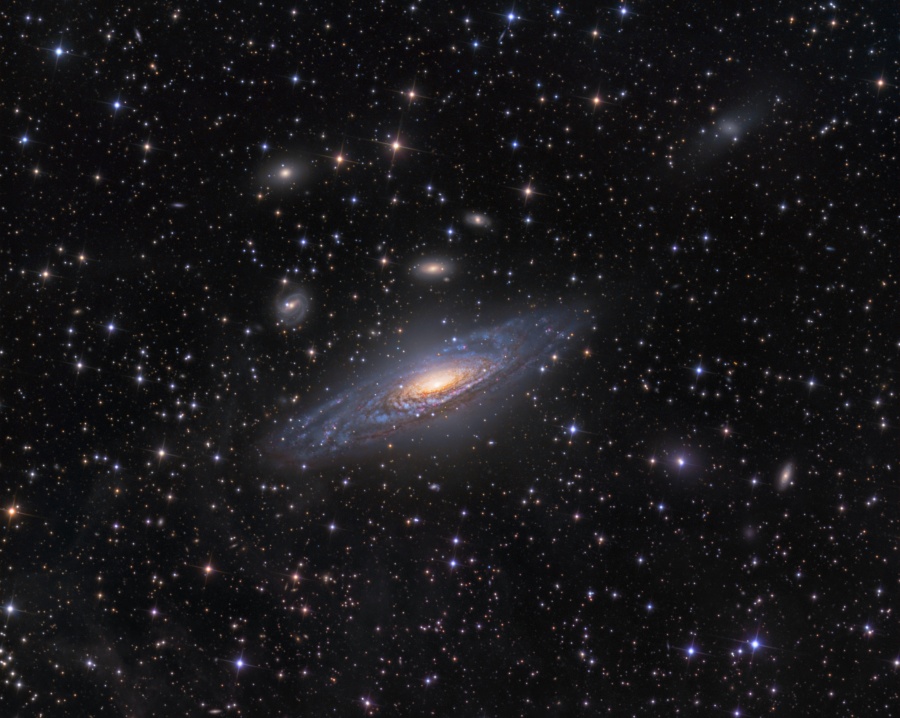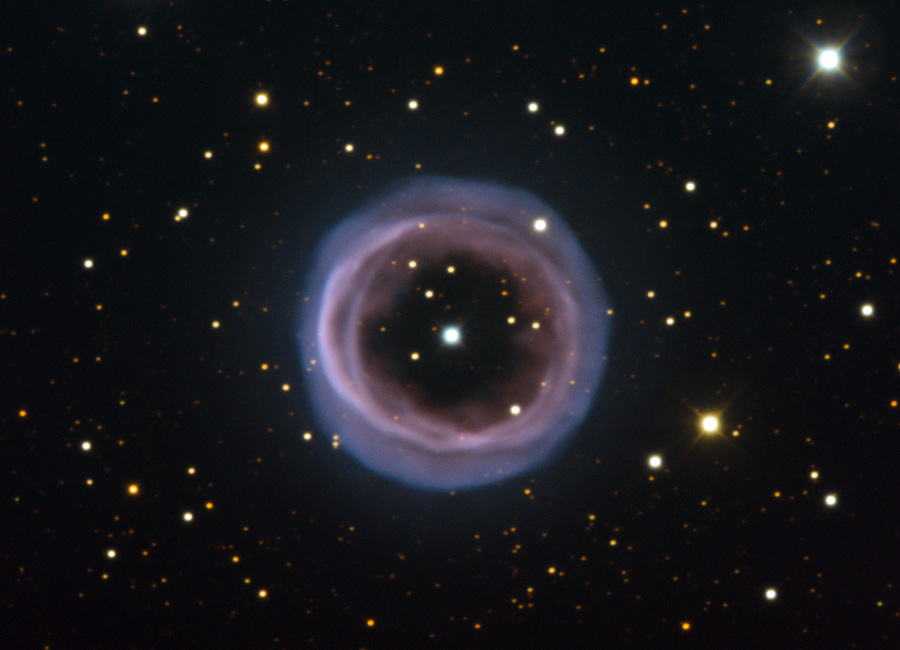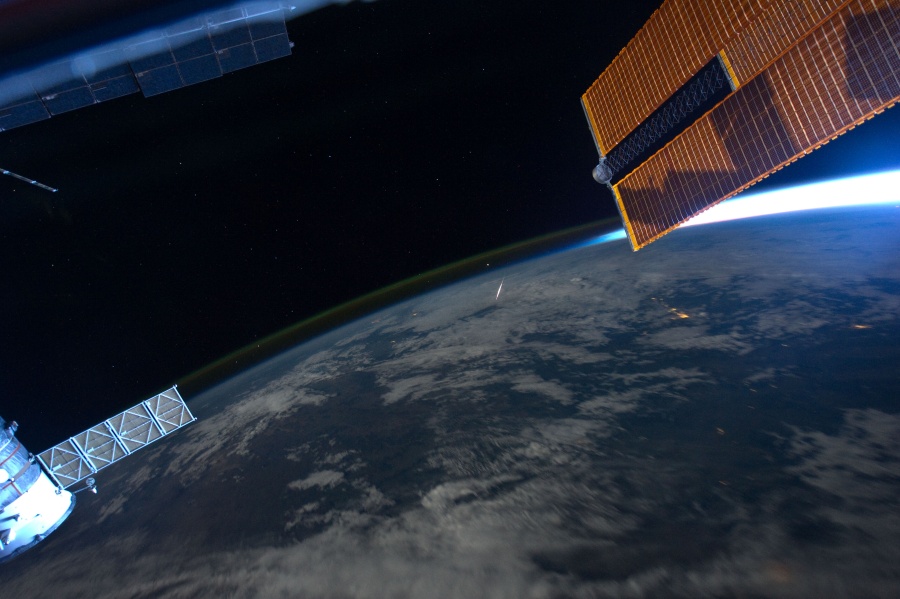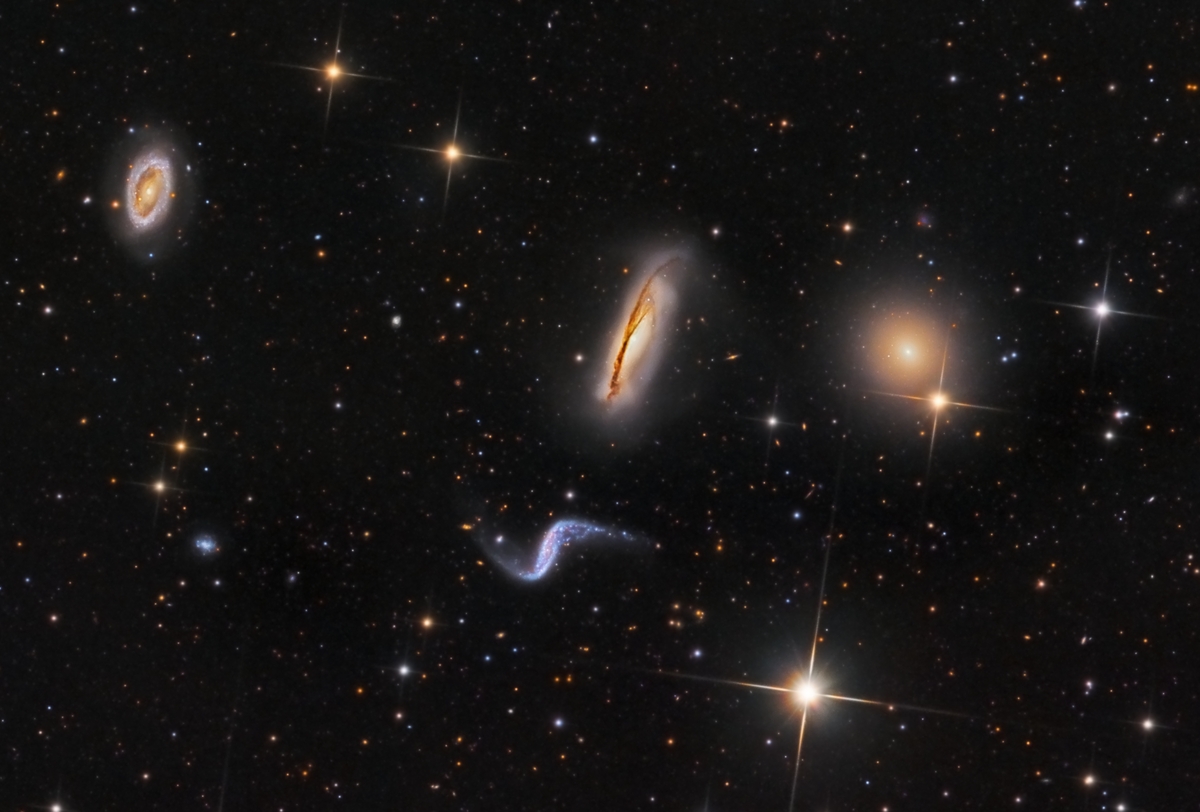_____________________________________________________________________
Please vote for the two best APODs (image and text) for August, 2011. All titles are clickable and link to the original APOD page.
We ask for your help in choosing an APOM, as this helps Jerry and Robert create "year in APOD images" review lectures and a free PDF calendar at year's end, and provides feedback on which images and APODs were relatively well received.
We are very interested to know why you selected the APODs for which you voted; if you would like to tell us, please reply to this thread. Thank you!
Thank you!
_____________________________________________________________________
<- Previous month's poll
What's that strange bright streak? It is the last image ever of a space shuttle from orbit. A week and a half ago, after decoupling from the International Space Station, the Space Shuttle Atlantis fired its rockets for the last time, lost its orbital speed, and plummeted back to Earth. Within the next hour, however, the sophisticated space machine dropped its landing gear and did what used to be unprecedented -- landed like an airplane on a runway. Although the future of human space flight from the USA will enter a temporary lull, many robotic spacecraft continue to explore our Solar System and peer into our universe, including Cassini, Chandra, Chang'e 2, Dawn, Fermi, Hubble, Kepler, LRO, Mars Express, Messenger, MRO, New Horizons, Opportunity, Planck, Rosetta, SDO, SOHO, Spitzer, STEREO, Swift, Venus-Express, and WISE.
Fix your digital camera to a tripod, start a long series of exposures, and you too can record star trails. The concentric arcs traced by the stars as planet Earth rotates on its axis often produce dreamlike scenes in otherwise familiar situations. Fall asleep, though, and the results might surprise you. Setting up on a summer night, photographer Mike Rosinski began his exposures, initially planning to capture about 45-55 minutes worth of star trails from his yard in Hartland, Michigan, USA. But he dozed, only to awaken some 3 hours later to find his camera had continued to run until the battery died. Composing the resulting images, the graceful concentric star trails were expected, along with light from a late rising Moon glinting on windows. Still, as he slept on the warm night a blizzard of yellow streaks flooded the scene, not left by fairies but fireflies.
Big, beautiful spiral galaxy NGC 7331 is often touted as an analog to our own Milky Way. About 50 million light-years distant in the northern constellation Pegasus, NGC 7331 was recognized early on as a spiral nebula and is actually one of the brighter galaxies not included in Charles Messier's famous 18th century catalog. Since the galaxy's disk is inclined to our line-of-sight, long telescopic exposures often result in an image that evokes a strong sense of depth. The effect is further enhanced in this sharp image by galaxies that lie beyond the gorgeous island universe. The background galaxies are about one tenth the apparent size of NGC 7331 and so lie roughly ten times farther away. Their close alignment on the sky with NGC 7331 occurs just by chance. Seen here through faint foreground dust clouds lingering above the plane of Milky Way, this visual grouping of galaxies is also known as the Deer Lick Group.
What happens when a star runs out of nuclear fuel? For stars about the mass of our Sun, the center condenses into a white dwarf while the outer atmospheric layers are expelled into space and appear as a planetary nebula. This particular planetary nebula, pictured above and designated Shapley 1 after the famous astronomer Harlow Shapley, has a very apparent annular ring like structure. Although some of these nebulas appear like planets on the sky (hence their name), they actually surround stars far outside our Solar System.
Denizens of planet Earth watched this year's Perseid meteor shower by looking up into the moonlit night sky. But this remarkable view captured by astronaut Ron Garan looks down on a Perseid meteor. From Garan's perspective onboard the International Space Station orbiting at an altitude of about 380 kilometers, the Perseid meteors streak below, swept up dust left from comet Swift-Tuttle heated to incandescence. The glowing comet dust grains are traveling at about 60 kilometers per second through the denser atmosphere around 100 kilometers above Earth's surface. In this case, the foreshortened meteor flash is right of frame center, below the curving limb of the Earth and a layer of greenish airglow. Out of the frame, the Sun is on the horizon beyond one of the station's solar panel arrays at the upper right. Seen above the meteor near the horizon is bright star Arcturus and a star field that includes the constellations Bootes and Corona Borealis. The image was recorded on August 13 while the space station orbited above an area of China approximately 400 kilometers to the northwest of Beijing.
This aurora arched from horizon to horizon. During the current Shelios expedition to observe and learn about the northern lights, the sky last weekend did not disappoint. After sunset and some careful photographic planning, the above image was taken from the expedition's Qaleraliq campsite in southern Greenland. Visible straight through the center of the aurora, found with a careful eye, is the Big Dipper and the surrounding constellation of the Big Bear (Ursa Major). The brightest orb on the far right is the Moon, while Jupiter can be seen even further to the right. The Shelios expedition is scheduled to last until the end of August and include live broadcasts of ongoing auroras.
Scanning the skies for galaxies, Canadian astronomer Paul Hickson and colleagues identified some 100 compact groups of galaxies, now appropriately called Hickson Compact Groups. The four prominent galaxies seen in this intriguing telescopic skyscape are one such group, Hickson 44, about 100 million light-years distant toward the constellation Leo. The two spiral galaxies in the center of the image are edge-on NGC 3190 with its distinctive, warped dust lanes, and S-shaped NGC 3187. Along with the bright elliptical, NGC 3193 at the right, they are also known as Arp 316. The spiral in the upper left corner is NGC 3185, the 4th member of the Hickson group. Like other galaxies in Hickson groups, these show signs of distortion and enhanced star formation, evidence of a gravitational tug of war that will eventually result in galaxy mergers on a cosmic timescale. The merger process is now understood to be a normal part of the evolution of galaxies, including our own Milky Way. For scale, NGC 3190 is about 75,000 light-years across at the estimated distance of Hickson 44.
<- Previous month's poll
Poll: Astronomy Picture of the Month for 2011 August
Poll: Astronomy Picture of the Month for 2011 August
A closed mouth gathers no foot.
-
BrianFarris
Re: Poll: Astronomy Picture of the Month for 2011 August
The absolute beauty of the auroa, its composition and depth are spectacular. As a photograph it is stunning and the best of the month. The meteor from the vantage of the shuttle gave me a perspective that i had not imagined before, and slightly edged out the sentimental favorite of the last shuttle re-entry photograph.
Re: Poll: Astronomy Picture of the Month for 2011 August
My first vote went to the Shuttle Reentry Streak from Orbit; this is a unique view of an object that will never be seen again. For all the work that the shuttles and shuttle astronauts did to provide service to the world, I could not NOT vote for this image. It is beautiful, unique, sad, and thrilling all at once.
My second vote went to Hickson 44 in Leo; it is a stunningly clear shot. Beautiful to look at, wonderful to contemplate.
I factor what is included and what I learn from the accompanying texts into the equation, too, when voting, and for the first image, the list of spacecraft is a lovely reminder of what is going on in space, and for the last, the text described what was going on clearly and succinctly. The links were great, too, for both images!
I like all the images depicted, but these were the ones which earned my two votes.
My second vote went to Hickson 44 in Leo; it is a stunningly clear shot. Beautiful to look at, wonderful to contemplate.
I factor what is included and what I learn from the accompanying texts into the equation, too, when voting, and for the first image, the list of spacecraft is a lovely reminder of what is going on in space, and for the last, the text described what was going on clearly and succinctly. The links were great, too, for both images!
I like all the images depicted, but these were the ones which earned my two votes.
A closed mouth gathers no foot.
-
Molly
Re: Poll: Astronomy Picture of the Month for 2011 August
My votes are emotional, poignancy over the last Shuttle missions and the beautiful photo. And I also love beautiful
galaxy photos, especially if they include other galaxies in the distance. It reminds me of how small I am and how lucky I am to be on planet earth and to live in an age of the Hubble Space Telescope.
galaxy photos, especially if they include other galaxies in the distance. It reminds me of how small I am and how lucky I am to be on planet earth and to live in an age of the Hubble Space Telescope.
Re: Poll: Astronomy Picture of the Month for 2011 August
Thx for votes to make 2nd place.
I thought interest in my NASA APOD image died, a few days ago I got email from The Wall Street Journal saying they wanted to use it with a book review "How We See the Sky: A Naked-Eye Tour of Day and Night" by Thomas Hockey.
After emails back/forth, and phone discussion, it ran in this Saturday WSJ paper(Nov-19) and online that day, $100 USD for limited usage.
My 1st sale, dinner for the family!
http://online.wsj.com/article/SB1000142 ... LS_Books_8
my wife snapped this via iPhone/facebook. (Starbucks sells the WSJ nationwide)
It was actually bigger than I thought it would be.

For the record, I did additional PP on this image:
-removed 40-ish hot red/green pixels spots
-tweaked the image via curves
it has more pop than the original NASA APOD did, that was a quickie dump the 370+ images and process them overnight thing.
I'll have to re-submit that to the editors for the end of year CD.
A sincere "Thanks" to everyone here...
I thought interest in my NASA APOD image died, a few days ago I got email from The Wall Street Journal saying they wanted to use it with a book review "How We See the Sky: A Naked-Eye Tour of Day and Night" by Thomas Hockey.
After emails back/forth, and phone discussion, it ran in this Saturday WSJ paper(Nov-19) and online that day, $100 USD for limited usage.
My 1st sale, dinner for the family!
http://online.wsj.com/article/SB1000142 ... LS_Books_8
my wife snapped this via iPhone/facebook. (Starbucks sells the WSJ nationwide)
It was actually bigger than I thought it would be.

For the record, I did additional PP on this image:
-removed 40-ish hot red/green pixels spots
-tweaked the image via curves
it has more pop than the original NASA APOD did, that was a quickie dump the 370+ images and process them overnight thing.
I'll have to re-submit that to the editors for the end of year CD.
A sincere "Thanks" to everyone here...
Mike R, P.E. .....iMac 27"(i7), iPad2, iPhone5s, 24" iMac, AppleTV(160), MacBook
Canon: 70D + lens:70-200 L f2.8 IS II / TC 1.4x 2x / 11-16 / 15-85 / f1.4 50
FEISOL tripod CT-3441S + CB-40D Ball Head / iOptron EQ tracker
http://apod.nasa.gov/apod/ap110805.html
Canon: 70D + lens:70-200 L f2.8 IS II / TC 1.4x 2x / 11-16 / 15-85 / f1.4 50
FEISOL tripod CT-3441S + CB-40D Ball Head / iOptron EQ tracker
http://apod.nasa.gov/apod/ap110805.html
- geckzilla
- Ocular Digitator
- Posts: 9180
- Joined: Wed Sep 12, 2007 12:42 pm
- Location: Modesto, CA
- Contact:
Re: Poll: Astronomy Picture of the Month for 2011 August
It only lost by one vote... ?! Yeesh! Amazing photo, Michael!
Just call me "geck" because "zilla" is like a last name.
